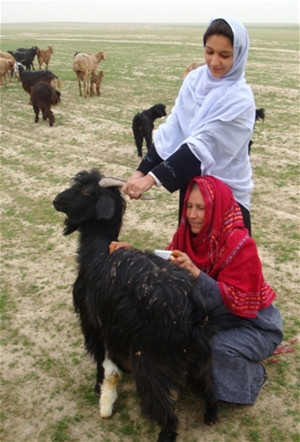Home » Reports & Data » Progress » Transforming Lives » Afghanistan Prepares to Fill Cashmere Demand

Women in Kunduz Province learn how to use combs to harvest valuable cashmere from their goats.
USAID/ASAP
USAID teaches goat herders to harvest and sell cashmere.
24 OCTOBER 2009 | KUNDUZ, AFGHANISTAN
Until recently, Afghans used their goats only for their milk, meat, wool, and leather. Now, more than 170,000 male and female goat herders are aware of the high value of cashmere and the proper methods to harvest and market this commodity.
USAID is implementing a cashmere awareness program across Afghanistan that reaches out to goat herders as well as Afghan traders interested in being part of a value chain that extends from Afghanistan to cashmere-hungry foreign markets.
USAID had set a target to train 150,000 male and female herders nationwide, but exceeded expectations. According to preliminary data, USAID has trained 171,416 herders, roughly a fifth of whom are women, and distributed 150,000 combs throughout Afghanistan’s 34 provinces. Based on its successful impact, USAID is continuing with the training program to increase awareness of this valuable commodity, which could boost rural incomes as well as the country’s exports.
Mohammad Rafiq is a master trainer who has trained 35 Kuchi community leaders in Kabul under the program. The community leaders bring the newly learned techniques back to their people and spread the message of cashmere’s value. “This process will go on so long as people are encouraged and provided with materials used for harvesting cashmere,” Rafiq said.
In another integral part of the program, USAID is setting up a national network of regional cashmere traders and is building their capacity to purchase cashmere from the goat herders for export to foreign markets.
Abdul Aziz Zarang has a warehouse that USAID is supporting during this year’s cashmere collection season. He plans to purchase cashmere harvested by herders from Kunduz and Balkh provinces and is excited about the opportunities ahead.
“As a result of this training, there will be a big impact on our business in the future,” Zarang said. “Cashmere in the northern region is of the highest quality in all of Afghanistan. There are a lot of opportunities for international buyers.”







Comment
Make a general inquiry or suggest an improvement.